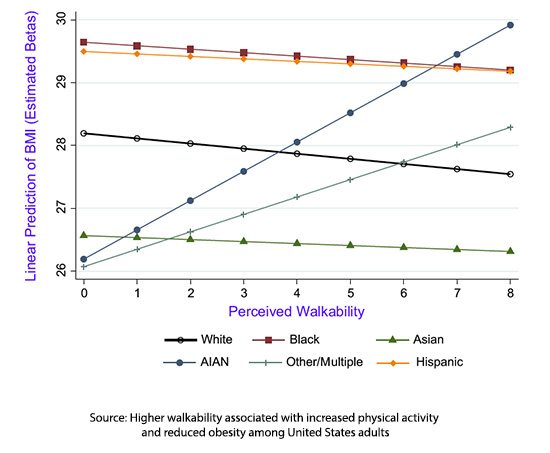The study looks at "walkability" – how conducive your neighborhood is to walking around. Not just the basics like a sidewalk and ample lighting but the presence of stores and things to do and see. Walkability also includes concerns about danger as you walk, either from miscreants or bikes and cars trying to run you off “their road.”
The data come from face-to-face interviews with adults over 18 from the CDC’s 2020 National Health Interview Survey. Physical activity was characterized as sufficient or insufficient based on being active for more than 150 minutes a week. Obesity was characterized as a BMI greater than 30. Walkability was based on the answers to eight questions:
- Where you live, are there roads, sidewalks, paths, or trails where you can walk?
- Are there shops, stores, or markets that you can walk to?
- Are there bus or transit stops that you can walk to?
- Are there places like movies, libraries, or places of worship that you can walk to?
- Are there places that you can walk to that help you relax, clear your mind, and reduce stress?
- Where you live, do most streets have sidewalks?
- Does traffic make it unsafe for you to walk?
- Does crime make it unsafe for you to walk?
Except for questions 7 and 8, the more "yes" answers, the greater the neighborhood's walkability.
In general, more active individuals lived in areas of higher walkability. And generally, walkability was greatest in central metro areas (73%) and tapered off as you became more suburban and rural (29%). Some take-home observations:
- Living in a neighborhood perceived as highly walkable increased walking by about 50%, compared to those living in poorly walkable neighborhoods.
- Living in neighborhoods with high perceived walkability was associated with lower BMI; you were 25% less likely to have a BMI of over 30 than those in poorly walkable neighborhoods.
- Of course, other variables go into our weight besides the neighborhood’s built environment. There are the neighborhood’s socioeconomics, poverty, education, crime, etc. But the researchers determined using mediation analysis that roughly 25% of the effect of the neighborhood on weight was due to its walkability.
 Here is the breakdown of walkability, BMI, and race/ethnicity. Except for indigenous Americans and “other,” where the sample size was quite small, walkability resulted in lower BMIs.
Here is the breakdown of walkability, BMI, and race/ethnicity. Except for indigenous Americans and “other,” where the sample size was quite small, walkability resulted in lower BMIs.
However, the decrease in BMI was not remarkable; by my calculation, it was about 3%. More walkable neighborhoods were associated with more significant self-reported good health. I think we might conclude with two thoughts. First, walking is a good physical activity; one does not have to join a gym, buy equipment, or even necessarily break a sweat. Second, our built environment affects our behavior. It is far harder to run to the “corner” store when it is in the strip mall three miles away than it is running to the bodega on the corner.
The 15-minute city
“The 15-minute city requires minimal travel among housing, offices, restaurants, parks, hospitals and cultural venues. Each neighbourhood should fulfil six social functions: living, working, supplying, caring, learning and enjoying.”
What makes a good neighborhood has been a question facing designers for decades. Jane Jacobs wrote about the destruction of communities, particularly her own, Greenwich Village, in 1961. Like many things in the time of COVID, the move towards these built neighborhoods got a push. Creating them does not require gentrification, although that has been a means of altering a neighborhood’s built environment. Improving the services that are already there, especially for food and healthcare, increases how comforting and navigable a neighborhood can be. New York City is not considered a 15-minute city, but I think they are looking at mid-town more than Queens or Brooklyn. Two of my favorite cities, Barcelona and Paris, are 15-minute cities, and to be honest, so was Battery Park when I lived there.
Could we reduce our waistlines by changing our neighborhoods to make walking to meet our needs easier than driving to them? Discuss among yourselves.
Sources: Higher walkability associated with increased physical activity and reduced obesity among United States adults Obesity DOI: 10.1002/oby.23634




